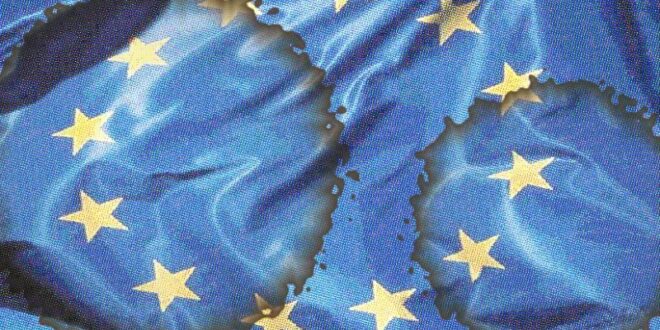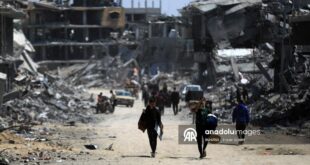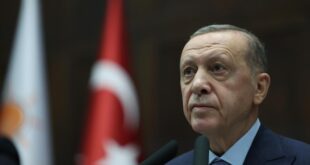Triangular economy of othering
Why does our West so vigilantly promote the so-called international trade all over the place? Answer is at hand; the US President George H.W. Bush clarifies: “No nation on Earth has discovered a way to import the world’s goods and services while stopping foreign ideas at the border.”[2]
There is a consensus within the academic community what was the critical factor in redefining the world’s periphery – from a sub-permafrost – Europe into the advanced West. Undeniably, it was the extension of its strategic depth westward, to the Americas upon 1492 – a huge continent unreported in the Bible and unknown to Europeans. There is also a consensus over the two factors facilitating the initiation of the age of Grand discoveries. The push effect was the fall of Constantinople, relative decline of the Maghrebian Arabs and the Ottoman techno-military and demographic threat onto Europe from south and southeast. And, the pull effect was the Ming dynasty inward retreat and to it related dismembering of the superior transoceanic Sino-fleet.[3]
This unleashed the so-called triangular transcontinental trade that incorporated one more previously unknown continent to Europe – (sub-Saharan) Africa. Triangular trade was a brutal instrument imposed by Europeans: Enslaved Africans shipped as cattle to America to dig for gold and silver which was destined for European colonial centres.[4] (Needleless to say that soon after American continent has been ‘discovered’, Europeans brutally derogated its indigenous civilisation. Only 100 years later, Americas have suffered loss of 90% of its total pre-colonial population – a final solution in one of its most effective workings. The same went on in sub-Saharan Africa. Far from being an undiscovered prior to the European conquistas, Africa was for many centuries an integral part of the Afro-Asian trading and manufacturing system. All that have dramatically changed with the arrival of Europeans. Soon after, they derogated an indigenous socio-political, civilizational and cultural and the demographic structures of Africa beyond the point of reparation.)
Once in Europe, stashes of these precious metals were used to cover massive European deficits created by extensive imports of the cutting-edge technologies, manufactured products, other goods and spices from a that-time superior Asia and the Middle East. Only later, gold and silver will be replaced by the equally powerful but less expensive ‘trade facilitators’ – iron and opium (guns and drugs). For instance, in early 1800s, many British MPs and cabinet ministers had shares in the UK narco-companies. Hence, the Narconomics was introduced and imposed as both a powerful strategic deterrent and as a wealth accumulator. (Eg. Still by the late 19th century, some 40 million mainland Chinese were heavy drugs addicts – roughly 10% of population.)
The Afro-America yields were so colossal for Atlantic Europe that many scholars assume the so–called Industrial revolution rather as an evolutionary anomaly than a natural socio-technological process of development, which was primarily pivoting in (Sino-Indian) Asia.[5] In order to illustrate a magnitude (or to validate the so called Schumpeterian creative destruction claim), let us note a following data: Starting from an early 16th century for consecutive 300 years, 85% of the world’s silver production and 70% of the world’s gold output came from the Americas. For the same period, 2/3 of globally manufactured goods were originating from Asia. Notably, while Europe spent unearned, Asia worked (to get gradually even pauperised through subsequent unfair trade practices, as Europe projected its military and ‘free trade’ dogma).
Further on, during the 17th, 18th and 19th century the role of Black slavery, slave trading, American Black slave-driven production centres and Negro markets, all significantly contributed to Atlantic Europe’s agricultural and industrial ‘breakthrough’ – as we are celebrating it today. In short, it was a wealth of Americas extracted by the enslaved men-power from Africa, and shipped to Europe under the minimal costs, all that for centuries.[6]
This colossal ‘oversea discovery’ reinforced Europe’s path on defensive modernisation (usage of technology for a narrow geostrategic end) – European empires building became a scientific project and the science evolved into an imperial project. For instance, French Dutch and Britons (the so-called second and third round of colonisers) learned one think from Portuguese and Spaniards (the first round of European colonisers) – nobody wishes to pay taxes but likes to invest. Therefore, their colonial expansion was primarily conducted as a corporate undertaking (West India company, East India company, WIC, VOC, Mississippi company, etc.)[7]
Hence, it was a magic vicious circle of scientifically erected empires and imperial capitalism: Credits financed overseas discoveries, discoveries led to colonies, colonies made profits (by imported slaves and rarefied locals), profits-built trust in tomorrows, and the trust in this shiny colonial tomorrow was translated into ever more credits for the larger corporate undertakings. Small wonder that the exegesis of (Newtonian science and Smith’s) capitalism started blindly to believe in a never-ending and ever-expanding economic growth. The fact that such a ‘faith’ contradicts all cosmic laws bothered none in that time Europe – the continent was dizzy and triumphant in its planetary conquest. Le Capitalisme Européen meant expansion – in every possible sense.
Such a rapid shift from a peripheral status to an ‘advanced civilization’ of course necessitated a complete reconstruction of western identity – furthering the weaponisation of religion for ideological purpose. These acrobatics –in return– caused the rift in Europe and enhanced the Continent’s continued split on two spheres: the Eastern/Russophone Europe – closer to and therefore more objective towards the Afroasian realities; and the Western (Atlantic/Scandinavian/Central) Europe, more dismissive, self-centred and ignorant sphere.
While the Atlantic flank progressively developed its commercial and naval power as to economically and demographically project itself beyond the continent, the landlocked Eastern Europe was lagging behind. It stuck in feudalism, and involuntarily constituted a cordon sanitaire – from eastern Baltic to Adriatic shores – against the Islamic Levant/south and the Russo-oriental East.
Gradually, past the 15th century, the idea of ‘Western Europe’ begun to crystallise as the Ottoman Turks and the Eastern Europeans were imagined and described as barbarians. During the 17th and 18th century as the triangular ‘trade’ progressed, Atlantic Europe firmly portrayed itself as the prosperous West that borders ‘pagan/barbarian’ neighbours to its near east, and the ‘savage subjects’ to its cross-Mediterranean south, overseas west, and the mystical Far East. Consequently, we cannot deny a huge role that the fabricated history as well as the ‘scientific’ racism and its theories played in a formation and preservation of European identity construct.[8]
The Enlightenment was a definite moment in the reinvention of European identity. The quest came along with the fundamental question who are we, and what is our place in the world? Answering that led on to the systematisation, classification of anthropogeographic inversion and – frankly – to reinvention of the world. From the Renaissance to the Enlightenment, a kind of an intellectual apartheid regime was forming.
(This historical anomaly I usually describe as anthropogeographic inversion in which the periphery asserted itself into the center by periferising that core and managing to present itself as a center. Thus, our current geopolitical and ideological core resides in geographic peripheries of the planet. It is in the hands of late developmental arrivals, such as the UK, Scandinavia, Russia, Canada, the US, Japan, Australia, New Zeeland, Korea, Singapore, South Africa. To achieve and maintain this colossal inversion was impossible without coercion over the extended space and time. Consequently, it necessitated a combination of physical and metaphysical (hard/coercion and soft/attraction) instruments: Physical military presence of the periphery in the center, combined with a tightly guarded narrative and constructed history. How does my anthropogeographic inversion theory correspond with an institutional interpretation of history? Real anthropogeographic peripheries are certainly a new civilizational arrival – Interference, intrusion and discontinuity is suffered in a core not on edges. (E.g. It is not centrally positioned Syria, Iraq, Iran or Afghanistan intervening in the geographic peripheries, such as the UK, US, Russia, Canada.) Periphery faster coagulates as it is rarely intruded. Center itself melts and is melted constantly. In the world of our realities; periphery sends, center absorbs.)
The rise of the West was portrayed as a pure virgin birth as John M. Hobson fairly concluded. Europeans delineated themselves as the, only or the most, progressive subject of the world’s history in past, presence and future. At the same time, the Eastern peoples – e.g. Asian as ‘the people without history’ – were seen as inert, passive and corrosive.[9] While the Solar system ‘became’ heliocentric, the sake and fate of our planet turned plain – Europocentric. The world is flat mantra set the stage, turning all beyond Europe into a sanitarycorridor, a no-fly-zone.
Ambient, anti-Orient
“The idea of Europe found its most enduring expression in the confrontation with the Orient in the age of imperialism. It was in the encounter with other civilizations that the identity of Europe was shaped. Europe did not derive its identity from itself but from the formation of a set of global contrasts. In the discourse that sustained this dichotomy of Self and Other, Europe and the Orient became opposite poles in a system of civilizational values which were defined by Europe.” – notes Delantry.
Even the English word to determine, position, adapt, adjust, align, identify, conform, direct, steer, navigate or command has an oriental connotation. To find and locate itself opposite to Orient, means to Orient oneself.
Feudal Europe had identified itself negatory towards Levant and Islam. It reinvented a historical unity and continuity of Roman Empire (precursor of today’s Euro-MED) into an us-them binary[10] categorisation: The peripheral outcast became thus the Rome (Western Empire) and the legitimate successor – who outlived its move to Bosporus for over 1.000 years – became peripheral, ‘Byzantium’.[11] No wonder, tireless binary categorisation is an essential glue and galvaniser.
Clearly, it was an identity heavily resting on insecurity. Proof? An external manifestation of inner insecurity is always aggressive assertiveness.
Is this still alive or even operative? How does it correlate today?
Europe repeatedly missed to answer to the East and Middle East through a dialogue (instruments) and consensus (institutions) although having both (via CoE; OSCE’s MPC; EU’s ENP, Barcelona Process, etc.). For the past 31 years, it primarily responded militarily in the MENA (or/and with sanctions, which is also a warfare, a socio-economic one) – via ‘Coalitions of the Willing’ (justified by the West and the Rest, Democracy vs. Putinism mantra). However, for a rapidly economically and demographically contracting Europe, the confrontation does not pay off anymore. While practically still yesterday (by the end of WWII), four of the five largest economies were situated in Europe, today only one is not in Asia. None is in Europe.[12]
(Likewise, while the US economy contributed with 54% of the world output in 1945, today it hardly covers 1/3 of that share. Hence, Americans are not fixing the world any more. They are only (partially) managing its decline. Look at their footprint in former Yugoslavia, Afghanistan, Iraq, Libya, Mali, Yemen, Syria or today in Ukraine.)
The same way the Islam has started as an exclusive Arab monopoly to be soon after taken over (for good) by the Turks, Persians and southeast Asians (who are today far more enhanced), the same way the Modern age has started with Europe. But today it is a planetary undertaking that the least resides within its originator. Simply, the Old Continent is not a wealthy club anymore. It is a theater with a memory of its wealthy past. Presently, Asia, Africa, Latin America are rapidly self-actualising and learning much more from each other than from the West.
And, Europe? Still to this very day, its national institutions are too quickly turning to culture and identity to explain politics, especially at election times. Of course, insisting – in the best spirit of the religious dogma – on the infallibility of its narrative. As simple and convenient as it seems, it is not as accurate as such. All across Europe, the governments repeatedly failed at distributive justice (just recall the Corona shame), not on culture or behavioural recognition. Thus, the EU has to learn how to deescalate and compromise. Certain identity cannot be put in line only with its geography. It has to respond to other realities as well. This is in the Continent’s best interest, for the sake of its only viable future. Therefore, it is a high time for the Brussels-headquartered Europe to challenge its rigid socio-political choices, and to evolve in its views and actings – for at home and for abroad.
Due to emergence of Asia, Europe will never be as central to the US and Russia as it used to be after the WWII, least after Brexit. Therefore, an old Continent will have to focus on ensuring the survival of its own model of multilateralism before being again able to claim any global ambition. There is no time for re-invention of European postcolonial cartography – be it Kiev, Khartoum or Kinshasa.
If we are any serious, let us start by answering the following: Is the so-called Russian expansionism or MENA ‘Islamofascism’ spontaneous or provoked, is that nascent or only a mirror image of something striking in front of it? And after all, why the indigenous Europe’s Muslims (those of the Balkans) and their twins, indigenous Christians of MENA (those of Levant) are now two identically slim shadows on a (bullet holes scarred) wall; while Ukrainians – whom we ‘protect’ Europeanisticly for the past several decades, are the most tragic the most dislocated the most income-gapped and the least secure national on the planet.
 Eurasia Press & News
Eurasia Press & News




